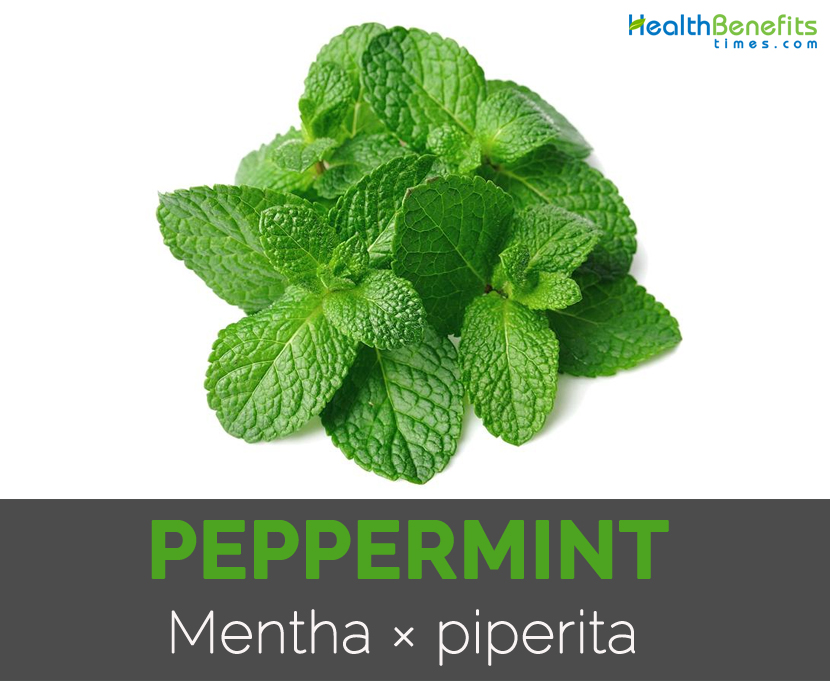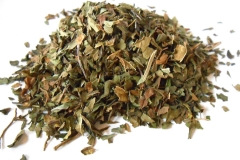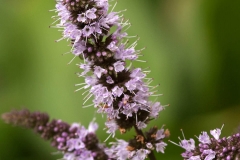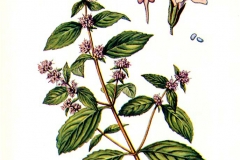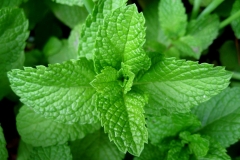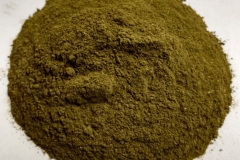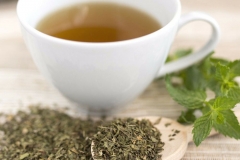Peppermint has square stems and smooth or dark green leaves and blunt oblong clusters of pinkish lavender flowers. Leaves are opposite, toothed and hairy on underside. The plant spreads aggressively with stolons i.e. underground stems. The natural hybridization among wild species resulted two types of peppermint: black and white. Peppermint oil is a volatile essential oil which is distilled with steam from the herb and used to flavor confectionery, dentifrices, chewing gum and medicines. The pure oil is nearly colorless which consists of menthol and menthone. The plant is found throughout Europe along stream banks and in waste lands.
Description
The rhizomatous perennial herb is about 30 to 90 cm high with quadrangular, purplish stems about 2 to 4 feet high. Leaves are short but distinctly stalked about 2 inches or more in length and ¾ to 1 ½ inches broad. Margins are finely toothed and surfaces are smooth both above and beneath. Flowers are reddish-violet found in axils of upper leaves forming loose and interrupted spikes and rarely bear seeds. Calyx is tubular having five sharp, hairy teeth and corolla is four cleft, stamens are four short and ovary is four celled and style projects ending in a bifid stigma. Plant has characteristic odor with volatile oil found in all parts.
Medicinal uses
- Tea made with peppermint leaves are used for treating fevers, digestive disorders, headaches and various minor ailments.
- Infusion is used for treating irritable bowel syndrome, spastic colon and digestive problems.
- Apply the lotion externally to skin providing relief from pain and reduce sensitivity
- Dilute it and inhale or chests rub to treat respiratory infections.
- Peppermint oil promotes relaxation, memory, concentration, energy and wakefulness.
- It lowers itchiness and discomfort of inflammation and joint pain.
- It provides relief sting of sunburns.
- Peppermint essential oil provides relief from cough, fatigue and back pain. Also helpful to promote circulation and relieve muscular pain, spasms and cramps.
- For colds, fill bowl with hot water adding few drops of peppermint oil. Then cover the head and bowl with towel and slowly breathe in.
Health benefits of Peppermint
- Digestive conditions
It is used for treating gas, ulcerative colitis, irritable bowel syndrome, dyspepsia, Crohn’s and colic. It stimulates digestive secretion through its choleretic and bitter properties. The bitter principle promotes pancreatic secretions and choleretic effects which stimulates the flow of bile and promotes solubility of bile.
- Infections
Peppermint has antiseptic and diaphoretic qualities which are helpful for treating colds and flu, coughs bronchitis and sinusitis. Peppermint may relieve digestive symptoms, such as gas, bloating and indigestion. Studies conducted on animal shows that peppermint soothes digestive system and eases pain. It prevents contracting of muscles and relieves spasms in gut. Warm peppermint teas promote perspiration and recovery.
- Relieve tension headaches
Peppermint acts as a pain reliever and muscle relaxant which diminishes certain types of headaches. Peppermint oil promotes blood flow and offers cooling sensation. Apply peppermint oil to forehead and temples to lower pain after two hours. The review of 14 clinical trials conducted on 2000 children showed that peppermint lowered frequency, length and severity of abdominal pain.
- Freshens breath
Peppermint is used as a flavoring for mouthwashes, toothpastes and chewing gum. Besides pleasing smell, it has antibacterial properties which eliminate germs which causes dental plaque and improves breath. Intake of peppermint tea improves breath.
- Relieve sinus
Peppermint has an antiviral, antibacterial and anti-inflammatory property which combats clogged sinuses due to infections, allergies and common cold. The peppermint tea has not been studies for effects on nasal congestion.
- Provides energy
Peppermint tea promotes energy levels and lowers daytime fatigue. The natural compounds provide beneficial effects on energy.
- Relieve menstrual cramps
Peppermint has muscle relaxant properties providing relief from menstrual cramps. Peppermint tea helps to improve the symptoms. The peppermint extract capsules are effective as non-steroidal anti-inflammatory drug in lowering the intensity and duration of pain.
- Combat bacterial infections
Peppermint tea has antibacterial effects that effectively kill bacteria. It prevents and eliminates growth of food borne bacteria including Salmonella, Listeria and E. coli and mango juice. It eliminates several types of bacteria resulting illness to humans including Staphylococcus and pneumonia linked bacteria.
- Improve sleep
Peppermint tea acts as muscle relaxant that helps to relax before bedtime. Peppermint helps to enhance sleep.
- Supports weight loss
Peppermint tea is calorie free and pleasantly sweet flavor making it a smart choice to lose weight. The peppermint oil capsule lowers appetite in comparison to taking peppermint.
https://www.youtube.com/watch?v=dk9v86Zlj9I
Culinary uses
- Leaves are consumed raw or cooked.
- It is used as a flavoring for salads and cook foods.
- The essential oil extracted from flowers and leaves are used to flavor chewing gum, sweets and ice cream.
- Dried leaves are used to make tea.
- Use it as a garnish or in potpourris.
Side Effects
- Avoid peppermint oil at the time of pregnancy.
- Consult the doctor before use to prevent side effects.
Other facts
- Mint is believed to cure hiccups.
- The propagation is done through plant cuttings.
- Essential oils and menthol extracted from mint leaves are used in toothpaste and mouthwashes.
- It is also used in aromatherapy and cosmetic industry for formation of creams, perfumes, lotions and shampoos.
References:
https://www.itis.gov/servlet/SingleRpt/SingleRpt?search_topic=TSN&search_value=32275#null
http://www.missouribotanicalgarden.org/PlantFinder/PlantFinderDetails.aspx?taxonid=281400
https://botanical.com/botanical/mgmh/m/mints-39.html#pep
http://www.ndhealthfacts.org/wiki/Mentha_piperita
https://mobile-cuisine.com/did-you-know/peppermint-fun-facts/
https://www.britannica.com/plant/peppermint
https://healthyhildegard.com/benefits-peppermint/
https://foodrevolution.org/blog/peppermint-health-benefits/
https://www.newworldencyclopedia.org/entry/Peppermint
http://www.softschools.com/facts/plants/mint_facts/610/
Comments
comments
| Peppermint Quick Facts | |
|---|---|
| Name: | Peppermint |
| Scientific Name: | Mentha × piperita |
| Origin | Europe and widespread throughout all regions of the world. |
| Taste | Aromatic, warm, pungent |
